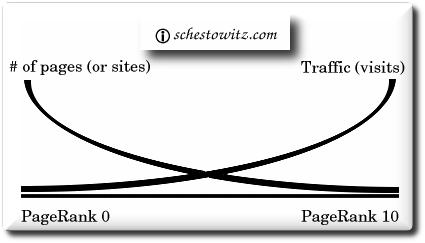Monday, August 22nd, 2005, 6:16 am
PageRank and Traffic
 oogle’s PageRank mechanism refelects on popularity estimates in most engines and directories, which presently adopt similar ranking methods that are based on the notion of citations (links).
oogle’s PageRank mechanism refelects on popularity estimates in most engines and directories, which presently adopt similar ranking methods that are based on the notion of citations (links).
The average webmaster would fall victim to an illusion. It always appears as if the majority of other sites have higher ranks. A question then springs to mind: how come most pages being visited have PageRank 4 or higher, for example, if they are only a small minority? The matter of fact is that much of the Web, including one’s own site have much lower ranks. That remote part of the Web is often virtually invisible to the errant surfer.
Let us recognise the fact that Google, Yahoo and CNN, for example, receive far more traffic than other sites. Their traffic is many orders of magnitude higher than that of the average site. To visualise this, I drew two exponential curves. Some figures suggest that the curves I drew for illustrational purposes should be far steeper. Some would suggest that at any level of PageRank the number of sites may be 3 times smaller and the traffic 3 times greater than that of the previous PageRank level.

The number of sites with PageRank 10 is tiny when compared to the number of sites with PageRank 0. Conversely, traffic is largely centralised in sites with a high PR.
To give an idea of how vast the World Wide Web actually is, the number of sites is slowly approaching 100 million (all registered global domains, as well individual parts of the world). At present, PageRank 0 may fit 50 million sites (some are not identified, not listed, or parked), PageRank 2: 5 million sites, PageRank 4: 500,000 sites and so forth. Of course this rough guess does not lead to the true numbers, which end up at just dozens of sites with PageRank 10.
In conclusion, always remember that the vast majority of sites is on the left-hand-side of the figure above, whereas some of the far more popular pages are on the (comparably) tiny number of pages on the right, e.g. the Google’s search page, the BBC front page or the W3 consortium pages.






 Filed under:
Filed under: 